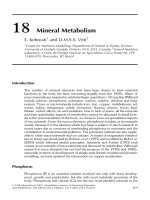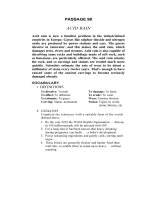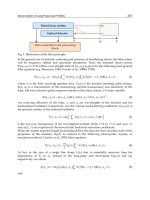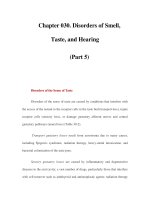Chapter 030. Disorders of Smell, Taste, and Hearing (Part 14) doc
Bạn đang xem bản rút gọn của tài liệu. Xem và tải ngay bản đầy đủ của tài liệu tại đây (82.53 KB, 6 trang )
Chapter 030. Disorders of Smell,
Taste, and Hearing
(Part 14)
In the event that the hearing aid provides inadequate rehabilitation,
cochlear implants may be appropriate. Criteria for implantation include severe to
profound hearing loss with word recognition score ≤30% under best aided
conditions. Worldwide, >20,000 deaf individuals (including 4000 children) have
received cochlear implants. Cochlear implants are neural prostheses that convert
sound energy to electrical energy and can be used to stimulate the auditory
division of the eighth nerve directly. In most cases of profound hearing
impairment, the auditory hair cells are lost but the ganglionic cells of the auditory
division of the eighth nerve are preserved. Cochlear implants consist of electrodes
that are inserted into the cochlea through the round window, speech processors
that extract acoustical elements of speech for conversion to electrical currents, and
a means of transmitting the electrical energy through the skin. Patients with
implants experience sound that helps with speech reading, allows open-set word
recognition, and helps in modulating the person's own voice. Usually, within 3
months after implantation, adult patients can understand speech without visual
cues. With the current generation of multichannel cochlear implants, nearly 75%
of patients are able to converse on the telephone. For individuals who have had
both eighth nerves destroyed by trauma or bilateral vestibular schwannomas (e.g.,
neurofibromatosis type 2), brainstem auditory implants placed near the cochlear
nucleus may provide auditory rehabilitation.
Tinnitus often accompanies hearing loss. As for background noise, tinnitus
can degrade speech comprehension in individuals with hearing impairment.
Therapy for tinnitus is usually directed towards minimizing the appreciation of
tinnitus. Relief of the tinnitus may be obtained by masking it with background
music. Hearing aids are also helpful in tinnitus suppression, as are tinnitus
maskers, devices that present a sound to the affected ear that is more pleasant to
listen to than the tinnitus. The use of a tinnitus masker is often followed by several
hours of inhibition of the tinnitus. Antidepressants have been shown to be
beneficial in helping patients cope with tinnitus.
Hard-of-hearing individuals often benefit from a reduction in unnecessary
noise (e.g., radio or television) to enhance the signal-to-noise ratio. Speech
comprehension is aided by lip reading; therefore the impaired listener should be
seated so that the face of the speaker is well-illuminated and easily seen. Although
speech should be in a loud, clear voice, one should be aware that in sensorineural
hearing losses in general and in hard-of-hearing elderly in particular, recruitment
(abnormal perception of loud sounds) may be troublesome. Above all, optimal
communication cannot take place without both parties giving it their full and
undivided attention.
Prevention
Conductive hearing losses may be prevented by prompt antibiotic therapy
of adequate duration for AOM and by ventilation of the middle ear with
tympanostomy tubes in middle-ear effusions lasting ≥12 weeks. Loss of vestibular
function and deafness due to aminoglycoside antibiotics can largely be prevented
by careful monitoring of serum peak and trough levels.
Some 10 million Americans have noise-induced hearing loss, and 20
million are exposed to hazardous noise in their employment. Noise-induced
hearing loss can be prevented by avoidance of exposure to loud noise or by regular
use of ear plugs or fluid-filled ear muffs to attenuate intense sound. High-risk
activities for noise-induced hearing loss include wood and metal working with
electrical equipment and target practice and hunting with small firearms. All
internal-combustion and electric engines, including snow and leaf blowers,
snowmobiles, outboard motors, and chain saws, require protection of the user with
hearing protectors. Virtually all noise-induced hearing loss is preventable through
education, which should begin before the teenage years. Programs of industrial
conservation of hearing are required when the exposure over an 8-h period
averages 85 dB. Workers in such noisy environments can be protected with
preemployment audiologic assessment, the mandatory use of hearing protectors,
and annual audiologic assessments.
ACKNOWLEDGMENT
The author acknowledges the contributions of Dr. James B. Snow, Jr., to
this chapter
FURTHER READINGS
Benton R: On the origin of smell: Odorant receptors in insects. Cell Mol
Life Sci 63:1579, 2006 [PMID: 16786219]
Breer H et al: The sense of smell: Multiple olfactory subsystems. Cell Mol
Life Sci 63:1465, 2004
Breslin PA, Huang L: Human taste: Peripheral anatomy, taste transduction,
and coding. Adv Otorhinolaryngol 63:152, 2006 [PMID: 16733339]
Dulac C: Sparse encoding of natural scents. Neuron 50:816, 2006 [PMID:
16772164]
Gates GA, Mills JH: Presbycusis. Lancet 366:1111, 2005 [PMID:
16182900]
Gudziol V et al: Clinical significance of results from olfactory testing.
Laryngoscope 116:1858, 2006 [PMID: 17003712]
Heckmann JG, Lang CJ: Neurological causes of taste disorders. Adv
Otorhinolaryngol 63:255, 2006 [PMID: 16733343]
Lalwani AK (ed): Current Diagnosis and Treatment in Otolaryngology—
Head & Neck Surgery, 2d ed. New York, McGraw-Hill, 2007
Rennels M, Pickering LK: Sensorineural hearing loss in children. Lancet
365:2085, 2005 [PMID: 15964436]









